Prevention & Preparedness
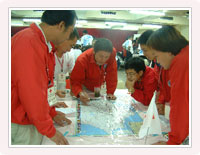
After 140 years of development, the Red Cross Movement’s scope of relief has broadened from war and armed conflicts to natural disasters and other man-made disasters—ranging from emergency relief to non-emergency medical rescue, disaster response, disaster reconstruction and preparedness, the last of which is listed as one of the core tasks for the next decade. The International Federation of Red Cross and Red Crescent Societies formulated Strategy 2020, a comprehensive work plan for the years 2010-2020. The strategic aims for Strategy 2020 focus on disaster response and preparedness, improving living environments, and promoting humanitarian values and principles.
Disasters are likely to happen in succession and we must be prepared for them at all times. The Society has effectively implemented disaster preparation and response plans and has established Disaster Preparedness Centers in 25 counties and cities throughout Taiwan, where disaster management courses are offered to full-time staff and volunteers. Volunteers may take part in basic search-and-rescue and preparedness training and may further their training in the United States.
Adhering to the IFRC's SOP, the Society published the Relief and Disaster Preparedness Operations Manual and other related training material for use in training disaster relief volunteers. Pre-disaster volunteer training can shorten wait times when a major disaster occurs, as the Red Cross may immediately dispatch rescue teams to provide humanitarian aid services.
Disasters are likely to happen in succession and we must be prepared for them at all times. The Society has effectively implemented disaster preparation and response plans and has established Disaster Preparedness Centers in 25 counties and cities throughout Taiwan, where disaster management courses are offered to full-time staff and volunteers. Volunteers may take part in basic search-and-rescue and preparedness training and may further their training in the United States.
Adhering to the IFRC's SOP, the Society published the Relief and Disaster Preparedness Operations Manual and other related training material for use in training disaster relief volunteers. Pre-disaster volunteer training can shorten wait times when a major disaster occurs, as the Red Cross may immediately dispatch rescue teams to provide humanitarian aid services.

【Local Geography & Disasters】
In order to be thoroughly prepared, we must first understand that Taiwan is vulnerable to many natural disasters. With Japan to the north and the Philippines to the south, Taiwan is located on the Pan-Pacific seismic belt, sitting on the collision point of the Eurasian and the Philippine Sea Plates. As a result, it is prone to typhoons, earthquakes, mudslides and floods caused by heavy rains. There are also man-made disasters: fires, toxic (chemical) spills or traffic disasters, such as plane crashes or train derailments.
With the above understanding, we conducted the Vulnerability and Capacity Analysis (VCA). Utilizing the results of the VCA, the Society worked with village communities to draft Community-Based Disaster Risk Reduction (CBDRR) plans, disaster preparedness plans based on analysis conducted on the region's most common disasters.
With the above understanding, we conducted the Vulnerability and Capacity Analysis (VCA). Utilizing the results of the VCA, the Society worked with village communities to draft Community-Based Disaster Risk Reduction (CBDRR) plans, disaster preparedness plans based on analysis conducted on the region's most common disasters.
【Evolution of Disaster Preparedness】
921 Earthquake: turning point for disaster preparedness
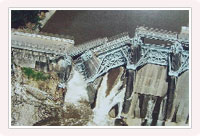
A 7.3 Richter scale earthquake struck Jiji, a rural township in Nantou Country, Taiwan, at 01:47 on September 21, 1999. 2,506 were killed or missing, 11,306 were injured and 106,685 households collapsed or had partially collapsed, causing heavy losses island-wide. A total of 390,454 disaster-stricken victims were documented. During the worst disaster in Taiwanese history, the Red Cross stepped up to combine resources at home and abroad to assist the government in assuming responsibility for disaster rescue and relief. The impact of this disaster also led the Society to realize the importance of and the need to establish an effective disaster preparedness and response system and related procedures.
Learning from disaster, growing from experience
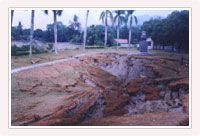
After conferring with the Danish Red Cross consultant at the end of 2001, the Society began organizing disaster preparedness and organizational development plans with the remaining donations from the 921 Earthquake Rehabilitation Fund. This project spanned a four-year period from June 1, 2002 to December 31, 2005 and was executed in five phases.
Disaster Preparedness & Organizational Development Project
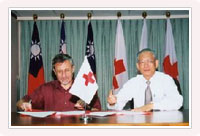
After conferring with the Danish Red Cross consultant at the end of 2001, the Society began organizing disaster preparedness and organizational development plans with the remaining donations from the 921 Earthquake Rehabilitation Fund. This project spanned a four-year period from June 1, 2002 to December 31, 2005 and was executed in five phases.
Project goals included:
- Set-up Disaster Preparedness Centers and construct a network between Red Cross HQ and branches.
- Establish management and utilization guidelines to improve disaster preparedness and relief efficiency.
- Further recruit volunteers to conduct disaster preparedness training.
- Create and issue disaster preparedness manuals and training guides.
- Train seed instructors to strengthen the dissemination of Red Cross knowledge.
- Establish professional action teams (relief task forces).
Concrete results are as follows:
- Completed the Relief and Disaster Preparedness Operations Manual, which outlines cooperation and disaster preparedness mechanisms between Red Cross HQ and its branches.
- Established 25 Disaster Preparedness Centers.
- Red Cross personnel training: conducted disaster management training for full-time staff, volunteer training in basic search-and-rescue and disaster preparedness, and completed disaster preparedness guidelines and teaching materials.
- Established professional action teams (search-and-rescue teams).
- In addition to existing onshore emergency, home services and water safety rescue volunteer teams, further established relief (disaster) teams, youth service teams and community service teams to strengthen volunteer manpower and implement community service.
【Disaster Preparedness Centers】
By constructing Disaster Preparedness Centers, the Society aims to provide rescue victims with daily necessities in a timely fashion following a disaster, demonstrating the Red Cross humanitarian spirit. The Society also established the Disaster Preparedness Center Management Guidelines and set aside a NT$800,000 disaster relief reserve fund for each branch. With regards to disasters caused by typhoons and earthquakes, we established the Minor Disaster Relief Guidelines with the intent to provide the most immediate relief to disaster victims. At present, we are Taiwan's sole rescue preparedness resource logistics network. From here the Society will strive to strengthen collaboration with the government and other NGOs in terms of communication, coordination and cooperation.
Our Disaster Preparedness Centers have the following supplies stocked:
Relief Supplies
Tents, sleeping bags, blankets and other daily commodities.
Our Disaster Preparedness Centers have the following supplies stocked:
Relief Supplies
Tents, sleeping bags, blankets and other daily commodities.
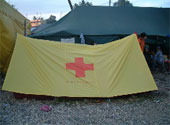
Tents (Type 1)
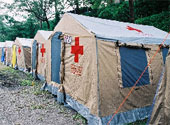
Tents (Type 2)
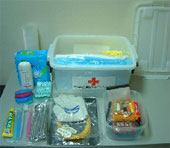
Daily Commodities Set
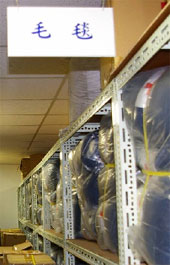
Wool Blankets
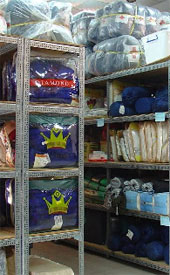
Summer Blankets
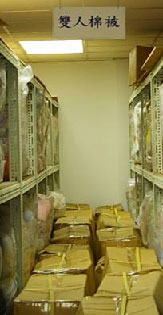
Twin-size Comforters
Relief Equipment & Devices
Water pumps, disc-shaped cutters, car rescue units, emergency lighting equipment, rescue ropes, wet suits, etc.
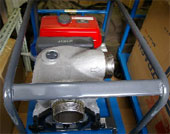
Water Pumps

Disc-shaped Cutters

Portable First Aid Kits
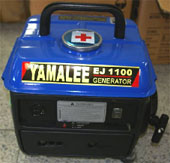
Small Generators
(For emergency lighting equipment)
(For emergency lighting equipment)
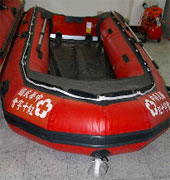
Liferafts

Liferaft Motors (30P)
Communications Equipment
Radios, handheld transceivers, radio transceivers, satellite phones, etc.
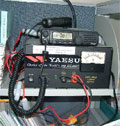
Radio Transceivers
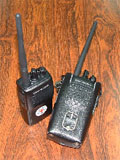
Handheld Transceivers

International Maritime Satellite Telephone

IDT Telephones
Transportation Equipment
Relief vehicles, 3.5-ton supply delivery trucks, etc.
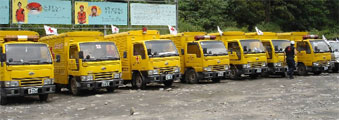
3.5-ton Supply Delivery Trucks
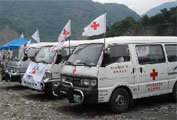
Relief Vehicles
Relief Volunteer Equipment
Heavy-duty flashlights, rope, gloves, face masks, helmets, and basic tool kits.
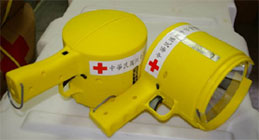
Heavy-duty Flashlights
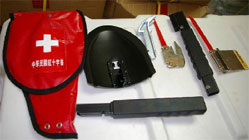
Basic Tool Kits
